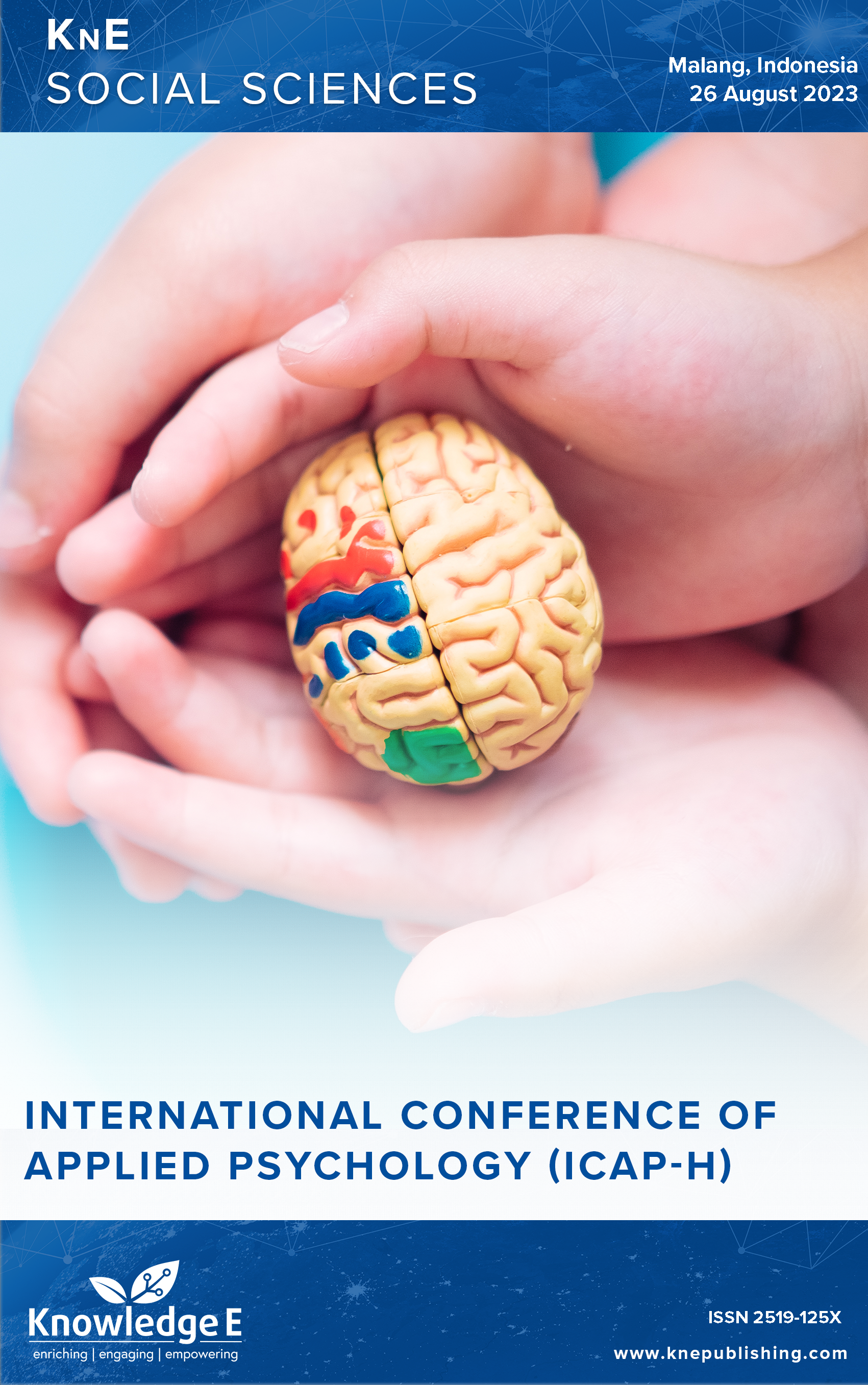Peer Attachment and Internalizing Problems in Adolescents
DOI:
https://doi.org/10.18502/kss.v9i5.15204Abstract
Peer Attachment is a close relationship between a person and their peers. Adolescents who have suitable attachment to their peers will experience fewer internalizing problems. Internalizing problems is a deepening of a person in dealing with the problems within him excessively. This study aimed to determine the relationship between peer attachment and internalizing problems in adolescents in East Java. This research is a nonexperimental quantitative research with a purposive sampling technique, and the number of samples in this study was 680 people. The criteria for this study were adolescents aged 15–18 years and domiciled in East Java. The scales used are the Inventory of Parent and Peer Attachment (IPPA) and the Strengths and Difficulties Questionnaire (SDQ). The results showed a negative relationship between peer attachment and internalizing problems marked by the value of r = –327, P = 0.000, which means that the higher the peer attachment in adolescents, the lower the level of internalizing problems they have.
Keywords: adolescence, peer attachment, internalizing problems
References
Santrock JW. Masa perkembangan anak. Jakarta: Penerbit Erlangga; 2011.
Saputro KZ. Memahami ciri dan tugas perkembangan masa remaja. Aplikasia: Jurnal Aplikasi Ilmu-ilmu Agama. 2018;17(1):25. DOI: https://doi.org/10.14421/aplikasia.v17i1.1362
Schoeps K, Mónaco E, Cotolí A, Montoya-Castilla I. The impact of peer attachment on prosocial behavior, emotional difficulties and conduct problems in adolescence: The mediating role of empathy. PLoS One. 2020;15(1):1–18. DOI: https://doi.org/10.1371/journal.pone.0227627
Achenbach T. Manual for the child behavior checklist and 1991 profile. Burlington: Department of Psychiatry, University of Vermont; 1991.
Zulnida EF. Hubungan masalah perilaku internalisasi dan eksternalisasi dengan tingkat kecerdasan pada remaja di Kota Bandung. Jurnal Ilmiah Psikologi Terapan. 2020;8(2):119. DOI: https://doi.org/10.22219/jipt.v8i2.12735
Danneel S, Nelemans S, Spithoven A, Bastin M, Bijttebier P, Colpin H, et al. Internalizing problems in adolescence: Linking loneliness, social anxiety symptoms, and depressive symptoms over time. Journal of Abnormal Child Psychology. 2019;47(10):1691–1705. DOI: https://doi.org/10.1007/s10802-019-00539-0
Hayat A. Kecemasan dan metode pengendaliannya. Khazanah: Jurnal Studi Islam dan Humaniora. 2017;12(1):52–63. DOI: https://doi.org/10.18592/khazanah.v12i1.301
World Health Organization. Mental health in the workplace [Internet]. 2019. Available from: https://www.who.int/mental_health/in_the_workplace/en/
Wahyuni NS, Psikologi F, Medan U. Hubungan dukungan sosial teman sebaya dengan kemampuan bersosialisasi pada siswa SMK Negeri 3 Medan. Journal of Diversity. 2016;2(2):1–11.
Armsden GC, Greenberg MT. The inventory of parent and peer attachment: Individual differences and their relationship to psychological well-being in adolescence. Journal of Youth and Adolescence. 1987;16(5):427–454. DOI: https://doi.org/10.1007/BF02202939
Salavera C, Usán P, Teruel P. The relationship of internalizing problems with emotional intelligence and social skills in secondary education students: gender differences. Psicologia: Reflexão e Crítica. 2019;32(1). DOI: https://doi.org/10.1186/s41155-018-0115-y
Ara E. Internalizing and externalizing problems in adolescents analyzing the gender difference. International Journal of Social Science Research. 2016;6(01):328–337.
Syakarofath NA, Biorohmi AN, Latipun L. The role of peer rejection in adolescent internalizing problems. J Psikol. 2021;20(2):140–151. DOI: https://doi.org/10.14710/jp.20.2.140-151
Muntamah M, Ariati J. Hubungan antara kelekatan terhadap teman sebaya dengan kematangan karir pada siswa kelas XI SMK Negeri 1 Trucuk Klaten. J Empati. 2016;5(4):705–710. DOI: https://doi.org/10.14710/empati.2016.15446
Astuti TH. Peer attachment pada mahasiswa yang mengikuti organisasi kemahasiswaan. Universitas Muhammadiyah Surakarta; 2019.
Spruit A, Goos L, Weenink N, Rodenburg R, Niemeyer H, Stams GJ, et al. The relation between attachment and depression in children and adolescents: A multilevel meta-analysis. Clinical Child and Family Psychology Review. 2020;23(1):54–69. https://doi.org/10.1007/s10567-019-00299-9 DOI: https://doi.org/10.1007/s10567-019-00299-9
Luijten CC, van de Bongardt D, Jongerling J, Nieboer AP. Longitudinal associations among adolescents’ internalizing problems, well-being, and the quality of their relationships with their mothers, fathers, and close friends. Social Science & Medicine. 2021;289:114387. https://doi.org/10.1016/j.socscimed.2021.114387 DOI: https://doi.org/10.1016/j.socscimed.2021.114387
Sugiyono. Metode penelitian kuantitatif, kualitatif dan R&D. Alfabeta; 2017.
Yani AD. Pengaruh peer attachment terhadap regulasi pada mahasiswa yang mengikuti organisasi daerah. Universitas Muhammadiyah Malang; 2020.
Connell AM, Goodman SH. The association between psychopathology in fathers versus mothers and children’s internalizing and externalizing behavior problems: A meta-analysis. Psychological Bulletin. 2002;128(5):746–773. DOI: https://doi.org/10.1037//0033-2909.128.5.746
Wiguna Tjhin, Manengkei Paul Samuel Kris, Pamela Christa, Rheza Agung Muhammad, Hapsari Windi Atika. Masalah emosi dan perilaku pada anak dan remaja di poliklinik jiwa anak dan remaja RSUPN dr. Ciptomangunkusumo (RSCM), Jakarta. Sari Pediatr. 2010;12(4):270–277. DOI: https://doi.org/10.14238/sp12.4.2010.270-7
Gorrese A. Peer attachment and youth internalizing problems: A meta-analysis. Child Youth Care Forum. 2016;45(2):177–204. DOI: https://doi.org/10.1007/s10566-015-9333-y
Lestari DA, Satwika YW. Hubungan antara peer attachment dengan regulasi emosi pada siswa kelas VIII di SMPN 28 Surabaya. Character: Jurnal Penelitian Psikologi. 2018;5(2):1–6.
Kholifah N, Sodikin S. Hubungan pola asuh orang tua dan lingkungan teman sebaya dengan masalah mental emosional remaja di SMP N 2 Sokaraja. J Keperawatan Muhammadiyah. 2020;5(2):99–108. DOI: https://doi.org/10.30651/jkm.v5i2.4961
Rahmat W. Pengaruh tipe kepribadian dan kualitas persahabatan dengan kepercayaan pada remaja akhir. Psikoborneo J Ilm Psikol. 2014;2(1):41–47. DOI: https://doi.org/10.30872/psikoborneo.v2i1.3572
Ediati A. Profil problem emosi/ perilaku pada remaja pelajar SMP-SMA di Kota Semarang. J Psikol Undip. 2015;14(2):190–198. DOI: https://doi.org/10.14710/jpu.14.2.190-198
Kendler KS, Gardner CO. Sex differences in the pathways to major depression: A study of opposite-sex twin pairs. American Journal of Psychiatry. 2014;171(4):426– 435. DOI: https://doi.org/10.1176/appi.ajp.2013.13101375
Pinheiro Mota C, Matos PM. Peer attachment, coping, and self-esteem in institutionalized adolescents: The mediating role of social skills. European Journal of Psychology of Education. 2013;28(1):87–100. DOI: https://doi.org/10.1007/s10212-012-0103-z
Desmita. Psikologi Perkembangan. Bandung: PT Remaja Rosdakata; 2013.

